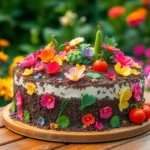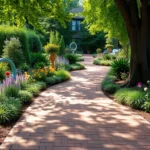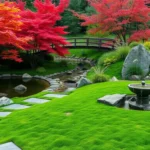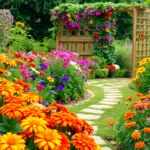We’ve all dreamed of having a lush garden but felt limited by our small outdoor spaces. Whether you’re working with a tiny balcony, compact patio, or even just a windowsill, small-space gardening opens up incredible possibilities that most people never consider.
The secret isn’t about having more room – it’s about maximizing every square inch you’ve got. We’ll show you how vertical gardens, container arrangements, and strategic plant selection can transform even the tiniest spaces into thriving green sanctuaries. From herb walls that supply your kitchen to flowering containers that brighten your mornings, small gardens often outperform their larger counterparts.
You don’t need acres to create something amazing. With the right techniques and creative thinking, we can help you build a garden that’s not only beautiful but incredibly productive in whatever space you’re working with.
Vertical Gardening Solutions for Maximum Space Efficiency
Wall-mounted planters transform bare vertical surfaces into productive growing areas that maximize our garden’s potential. We can install tiered planter systems on fences, walls, or balcony railings to create multiple levels of growing space without using additional floor area. These systems work exceptionally well for herbs like basil, thyme, and oregano, plus compact vegetables such as lettuce, spinach, and cherry tomatoes.
Living walls offer sophisticated vertical answers that turn entire wall surfaces into green spaces. We build these systems using modular pocket planters, felt growing systems, or wooden pallet gardens that accommodate dozens of plants in a compact footprint. Modern living wall systems include built-in irrigation lines that deliver water evenly to each plant pocket, making maintenance simpler for busy gardeners.
Trellis structures provide vertical support for climbing plants that naturally grow upward rather than outward. We install sturdy trellises for pole beans, peas, cucumbers, and morning glories that can reach heights of 6 to 8 feet while occupying minimal ground space. Wire mesh, bamboo poles, or decorative metal frameworks create attractive vertical displays that serve as both functional growing supports and privacy screens.
Hanging basket arrangements use overhead space that typically goes unused in small gardens. We suspend baskets at varying heights to create layered growing zones for trailing plants like strawberries, cherry tomatoes, and cascading flowers. Multiple hanging levels maximize our vertical real estate while keeping plants at comfortable harvesting heights.
Tower garden systems stack planting containers vertically to create column-style growing structures. We construct these towers using stackable planters, repurposed containers, or specialized tower kits that can accommodate 20 to 30 plants in a 2-foot square footprint. These systems work particularly well for strawberries, herbs, and leafy greens that don’t require extensive root systems.
Ladder plant stands repurpose old wooden ladders or step stools as tiered display platforms for container plants. We arrange potted plants on each rung to create an attractive stepped garden that fits easily into corners or against walls. This approach allows us to group plants with similar water and light requirements while creating visual interest through varied heights and textures.
Container Gardening Ideas That Transform Any Small Area

Container gardening opens up endless possibilities for cultivating plants in the smallest spaces. Creative containers make this gardening approach both accessible and budget friendly, allowing us to repurpose items we already have around our homes.
Creative Container Answers
Almost anything can become a planter with proper drainage and a bit of imagination. Old boots, wooden crates, and storage bins transform into unique growing vessels that add character to our small gardens. Budget friendly options include reusing household items instead of purchasing expensive planters, helping us create distinctive garden displays without important investment.
Drainage holes are essential for any container we choose, preventing waterlogged soil that can damage plant roots. We can drill holes in repurposed containers or add gravel layers at the bottom to improve water flow.
Best Plants for Container Gardening
Herbs excel in container environments and provide fresh ingredients for our kitchens throughout the growing season. Basil, parsley, thyme, mint, and cilantro thrive in small pots and require minimal space while delivering maximum flavor impact.
Compact vegetables offer excellent returns in limited growing areas. Cherry tomatoes produce abundant harvests in containers, while lettuce varieties grow quickly and can be harvested continuously for fresh salads.
Themed Container Garden Ideas
Salsa gardens bring all the ingredients together in one convenient location. We plant garlic in fall, then add tomatoes, peppers, onions, and cilantro in spring using a 20 gallon container placed in full sun. Fertilizing every two weeks ensures robust growth and abundant harvests.
Cocktail gardens create herb and fruit combinations perfect for entertaining. A 2 gallon container houses a Meyer lemon tree at the center, surrounded by strawberries, mint, basil, and thyme in bright, sunny locations.
| Container Type | Recommended Size | Best Plants | Maintenance |
|---|---|---|---|
| Salsa Garden | 20 gallons | Tomatoes, peppers, herbs | Fertilize bi-weekly |
| Cocktail Garden | 2 gallons | Lemon tree, berries, herbs | Full sun placement |
| Herb Collection | 1-3 gallons | Basil, parsley, thyme | Regular harvesting |
Essential Setup Requirements
Quality potting soil forms the foundation of successful container gardening. We combine commercial potting mix with compost to create nutrient rich growing medium that supports healthy plant development.
Plant compatibility ensures all container companions share similar needs for water, sunlight, soil conditions, and fertilizer requirements. Grouping plants with matching care needs prevents some from thriving while others struggle in the same container.
Low level organic fertilizer provides consistent nutrition without overwhelming plants in confined spaces. Regular feeding schedules maintain plant health and maximize production in our small space gardens.
Window Box Gardens That Maximize Limited Space
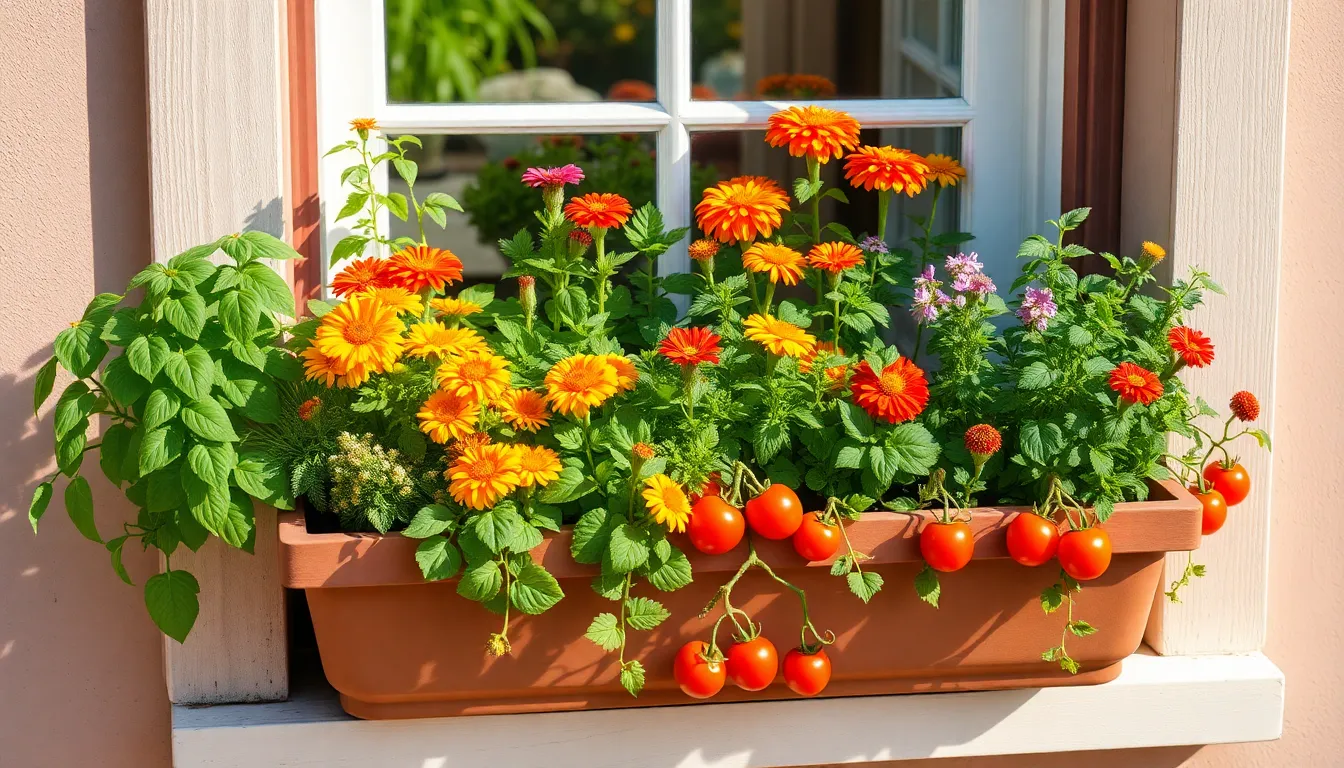
Window boxes offer one of the most accessible ways to create gardens in small spaces while utilizing often overlooked areas around our homes. We can transform windowsills into productive growing spaces that provide fresh ingredients and visual appeal without requiring ground space.
Herb Window Boxes for Kitchen Access
Installing herb window boxes near our kitchen creates the ultimate convenience for culinary gardening. We can grow fresh herbs like basil, rosemary, and thyme just steps away from our cooking area for immediate harvesting. This strategic placement allows us to snip herbs directly into our dishes while they’re cooking, ensuring maximum flavor and freshness.
Kitchen window herb boxes work exceptionally well because they receive consistent attention through daily use. We naturally monitor our herbs’ progress while washing dishes or preparing meals, making maintenance intuitive. Popular herb combinations include Mediterranean blends with oregano, sage, and lavender, or culinary essentials featuring parsley, chives, and cilantro.
The compact nature of most herbs makes them perfect candidates for window box cultivation. We can fit multiple varieties in a single box, creating diverse flavor profiles within arm’s reach of our cooking space.
Flowering Window Boxes for Curb Appeal
Flowering window boxes instantly enhance our home’s exterior appearance while maximizing small space gardening potential. We can create stunning displays using colorful annuals like petunias, geraniums, and marigolds that bloom continuously throughout the growing season. These vibrant arrangements add visual impact to otherwise plain exterior walls.
Seasonal rotation keeps our flowering window boxes interesting year round. We can plant cool season flowers like pansies and snapdragons in spring and fall, then switch to heat loving varieties during summer months. This strategy ensures consistent color and helps us make the most of our limited growing space.
Color coordination with our home’s exterior creates cohesive curb appeal that neighbors notice. We can choose complementary flower colors that enhance our house’s paint scheme or create bold contrasts for dramatic visual effects.
Vegetable Window Boxes for Fresh Produce
Vegetable window boxes transform small spaces into productive growing areas that supply fresh ingredients for our kitchen. We can successfully grow compact vegetables like lettuce, cherry tomatoes, and peppers in properly sized window boxes with adequate drainage. These crops provide substantial harvests relative to the minimal space they occupy.
Succession planting maximizes our vegetable window box productivity throughout the growing season. We can plant new lettuce seeds every two weeks for continuous harvests, or replace finished crops with new varieties to extend our growing period. This approach ensures steady production from our limited space.
Shallow rooted vegetables perform exceptionally well in window box environments. We can grow radishes, green onions, and small peppers that don’t require deep soil while still producing meaningful quantities of fresh produce for our meals.
Hanging Garden Systems for Overhead Growing
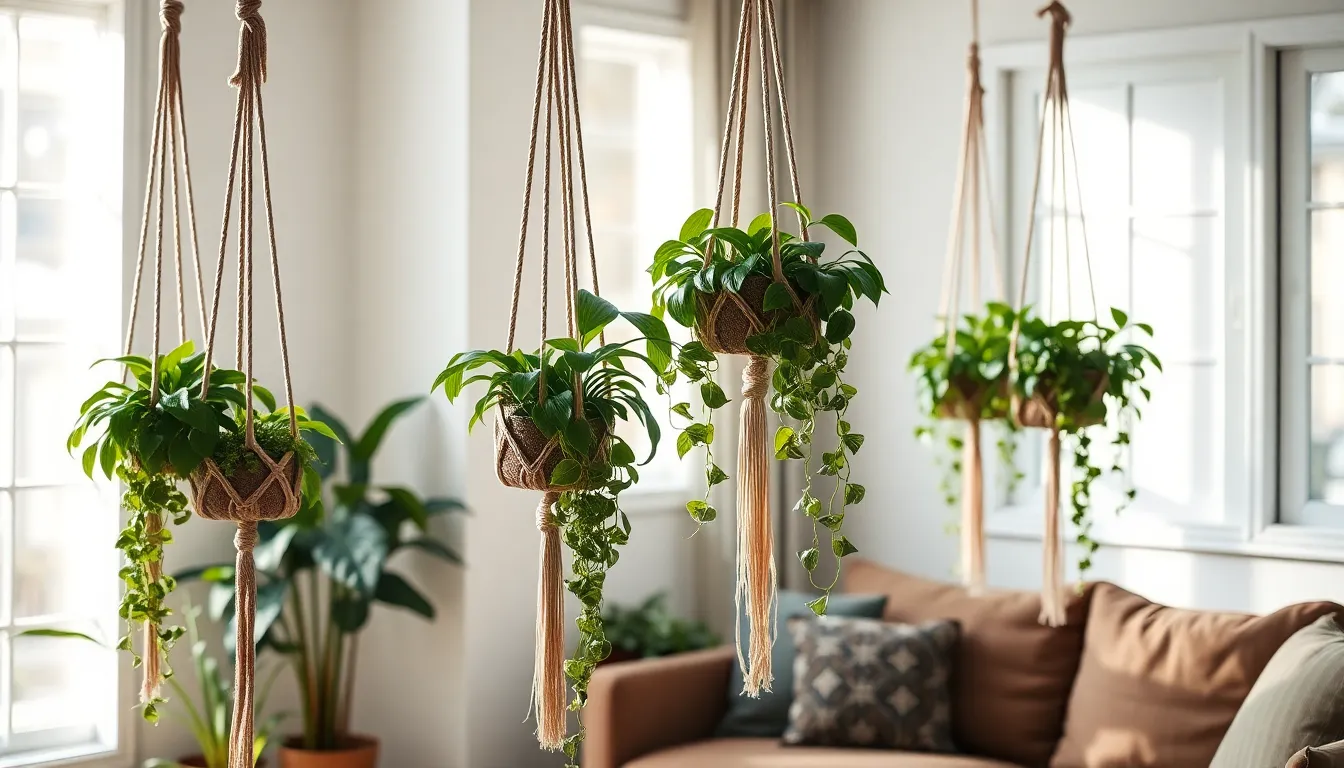
Moving beyond ground level gardening opens up exciting possibilities for maximizing our vertical growing space. These overhead systems transform unused ceiling and wall areas into productive growing environments.
Macrame Plant Hangers for Indoor Spaces
Macrame plant hangers bring both function and style to our indoor gardens. These decorative hanging answers perfectly complement our home décor while efficiently utilizing vertical space that would otherwise remain empty. We can create stunning displays by grouping multiple macrame hangers at varying heights, establishing visual depth and interest throughout our living spaces.
Choosing the right plants for macrame hangers maximizes their decorative impact. Trailing plants like pothos, spider plants, and string of pearls work exceptionally well in these hanging displays. We’ll want to select containers that complement the macrame design while ensuring proper drainage to prevent water damage to our floors and furniture.
Strategic placement of macrame hangers transforms any room into a green oasis. Positioning them near windows provides adequate light for plant growth while creating natural privacy screens. We can also use them to define spaces in open floor plans or add greenery to corners that receive minimal foot traffic.
Ceiling-Mounted Planters for Patios
Ceiling mounted planters revolutionize our outdoor growing space without sacrificing floor area. These overhead systems allow us to cultivate plants above our patio furniture and entertainment areas, creating a lush canopy effect. We can install multiple planters at different heights to accommodate various plant sizes and growth habits.
Weather resistant materials ensure our ceiling planters withstand outdoor conditions. Selecting planters made from materials like powder coated metal, treated wood, or UV resistant plastic protects our investment from sun damage and moisture. We should also choose plants that thrive in our exact climate conditions and light exposure levels.
Installation considerations make ceiling planters both safe and functional. Properly securing mounting hardware to ceiling joists or using appropriate anchors prevents accidents and plant loss. We’ll need to plan for easy access when watering and maintaining our overhead gardens, potentially using pulley systems for larger installations.
Wall-Mounted Hanging Gardens
Wall mounted systems transform vertical surfaces into productive growing areas. These space saving answers work particularly well on fences, exterior walls, and compact garden stands where horizontal space is limited. We can create thriving oases using materials like repurposed pallets or specialized industry fabric designed for vertical gardening.
Elevated pot systems add both height and visual interest to our gardens. Attaching pots to posts or mounting them on wall brackets creates ever-changing displays while conserving precious ground space. We can arrange these elevated planters in patterns that complement our outdoor design aesthetic while ensuring each plant receives adequate sunlight.
Creative mounting answers maximize our wall space potential. Using tiered shelving units, pocket planters, or modular systems allows us to accommodate multiple plants on a single wall surface. We should consider irrigation needs when planning these installations, potentially incorporating drip systems or self watering features to simplify maintenance.
Multi-Level Planting Strategies for Small Yards
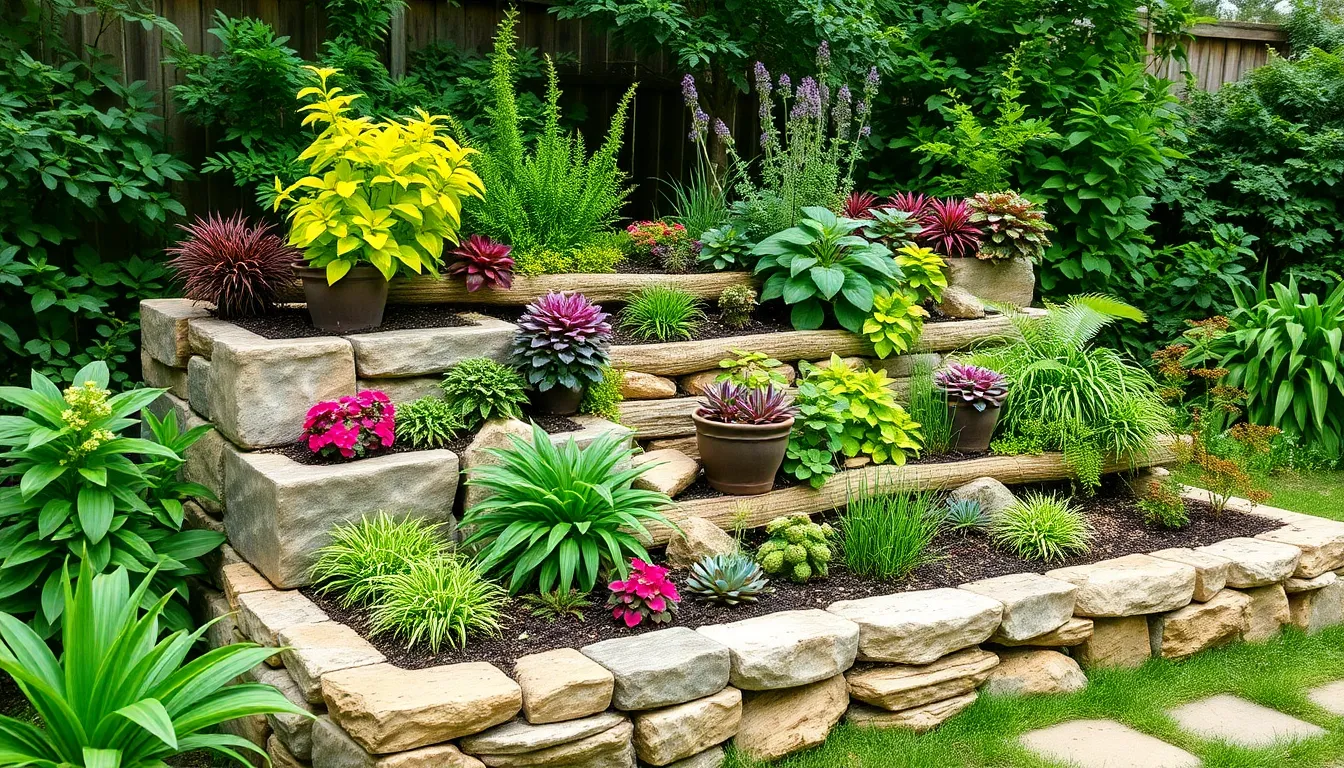
Creating dimensional growing spaces transforms compact yards into productive garden areas. We’ll explore effective techniques that maximize planting potential through strategic vertical arrangements.
Tiered Garden Beds for Dimensional Growing
Tiered garden beds create multiple levels of planting space that add visual dimension to small yards. We can construct these systems using wooden frames or natural stone materials to build stepped growing areas. Each tier provides distinct planting zones that accommodate different plant heights and growing requirements.
Building tiered beds involves creating stepped levels that cascade from back to front. The highest tier typically stands 18-24 inches tall while subsequent levels step down in 6-8 inch increments. This arrangement ensures all plants receive adequate sunlight while creating an attractive terraced appearance.
Plant selection for tiered beds follows height-based strategies. We place taller plants like tomatoes and peppers in back tiers while shorter herbs and lettuce occupy front sections. Each level functions as an independent growing zone with its own soil depth and drainage system.
Raised Bed Stacking Systems
Raised bed stacking systems maximize vertical space by layering growing areas on top of each other. These structures create multiple planting levels within a minimal ground footprint. We can stack beds 2-3 levels high while maintaining easy access for maintenance and harvesting.
Construction involves building sturdy bottom frames that support additional weight. The base level requires reinforced corners and thick lumber to bear the load of upper tiers. Each stacked level needs proper drainage holes and separation barriers to prevent soil mixing.
Stacking systems work best with lightweight plants and shallow-rooted varieties. Herbs, lettuce, and compact vegetables thrive in these arrangements. We recommend using quality potting mix in upper levels to reduce weight while maintaining proper nutrition for plant growth.
Ladder Planters for Vertical Appeal
Ladder planters transform old ladders into functional vertical growing structures. These repurposed items add rustic charm while providing multiple planting levels in a compact footprint. We can use wooden stepladders or create custom ladder frames specifically for gardening purposes.
Installation requires securing the ladder base and adding container platforms. Each ladder rung supports pots or planters at different heights creating a stepped growing display. Weather-resistant materials ensure longevity in outdoor conditions while proper anchoring prevents tipping.
Ladder systems excel at supporting climbing plants and trailing varieties. Vines naturally grow up ladder structures while herbs and flowers create cascading displays from each level. This vertical approach suits patios, deck areas, and narrow garden spaces where ground area is limited.
Indoor Small Space Garden Ideas for Apartments
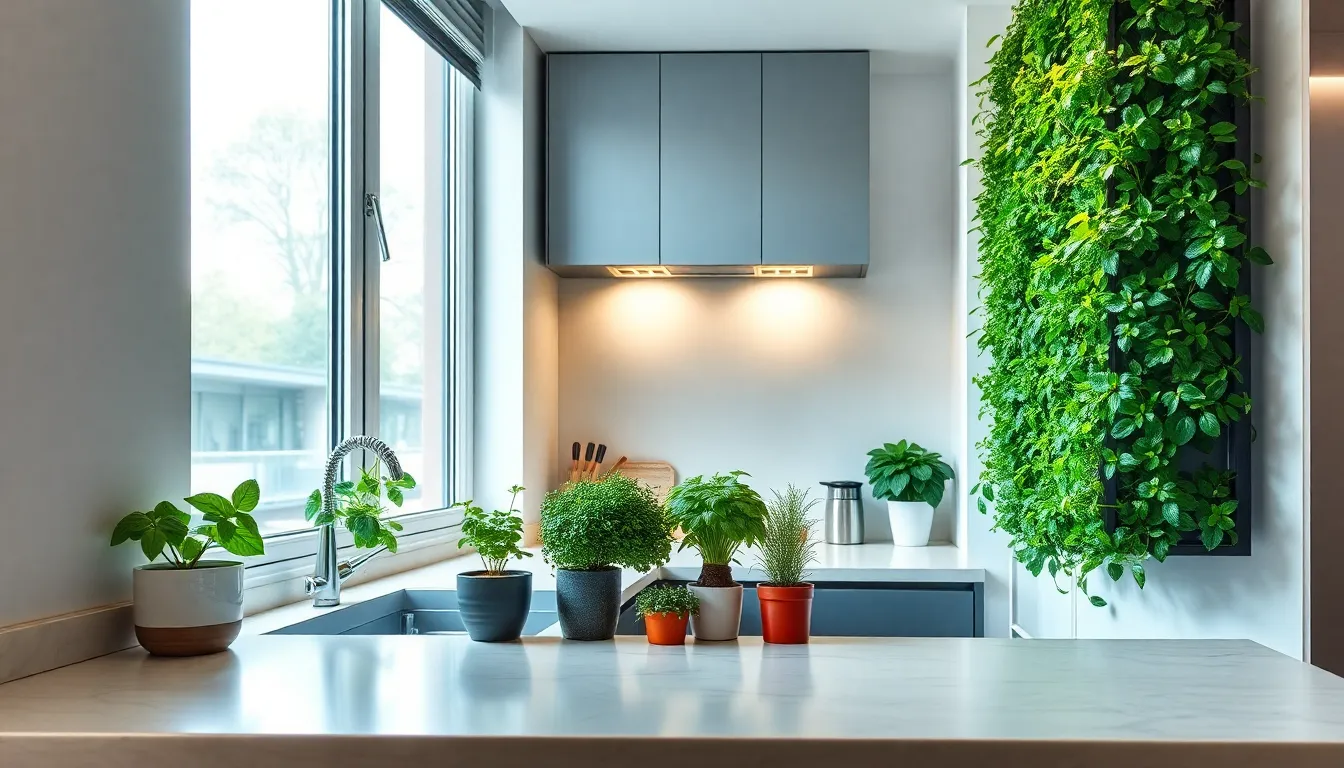
When outdoor space isn’t available, we can transform our apartment interiors into thriving gardens using clever indoor answers. Let’s explore practical approaches that maximize limited indoor square footage.
Countertop Herb Gardens
Countertop Herb Gardens transform small kitchen spaces into productive growing areas that provide fresh ingredients year-round. We recommend starting with easy-to-grow herbs like basil, mint, and rosemary that thrive in compact containers and require minimal maintenance. Small pots arranged on windowsills or kitchen counters create an accessible herb collection that’s perfect for daily cooking needs.
Container selection plays a crucial role in countertop success. We suggest using containers between 4-6 inches in diameter to accommodate herb root systems while fitting comfortably on limited counter space. Drainage holes prevent waterlogging, while saucers protect surfaces from water damage.
Strategic placement near south-facing windows ensures herbs receive adequate sunlight for healthy growth. We position faster-growing herbs like cilantro and parsley closer to the sink for easy watering, while slower-growing varieties like oregano and thyme work well in slightly less accessible spots.
Living Wall Systems
Living Wall Systems maximize vertical space by converting bare apartment walls into lush, productive gardens. We install modular planter systems that support various plant types while adding striking visual appeal to small indoor areas. These systems work particularly well in studio apartments where floor space is extremely limited.
Modular components allow us to customize wall gardens based on available space and plant preferences. We recommend starting with lightweight systems that don’t require extensive wall modifications, making them ideal for rental apartments. Built-in irrigation systems simplify maintenance by delivering consistent water distribution to all plants.
Plant variety options include trailing plants, compact vegetables, and air-purifying species that enhance indoor air quality. We suggest combining different textures and colors to create visually interesting displays that serve as living artwork while producing fresh herbs and greens.
Under-Cabinet Growing Answers
Under-cabinet growing answers use often-overlooked spaces beneath kitchen cabinets for productive plant cultivation. We install LED grow lights in these areas to create optimal growing conditions for herbs and microgreens without natural sunlight requirements. This approach works especially well for renters who can’t modify walls or windows.
Hydroponic systems fit perfectly in under-cabinet spaces, providing automated growing answers that require minimal daily attention. We recommend compact systems that accommodate 6-12 plants while fitting within standard cabinet depths. These systems eliminate soil mess while maximizing growth rates through controlled nutrient delivery.
Space optimization techniques include sliding trays that extend for easy access and stackable growing modules that increase plant capacity. We position frequently harvested plants like lettuce and herbs in the most accessible positions while slower-growing varieties can occupy deeper cabinet areas.
Balcony Garden Designs That Maximize Square Footage
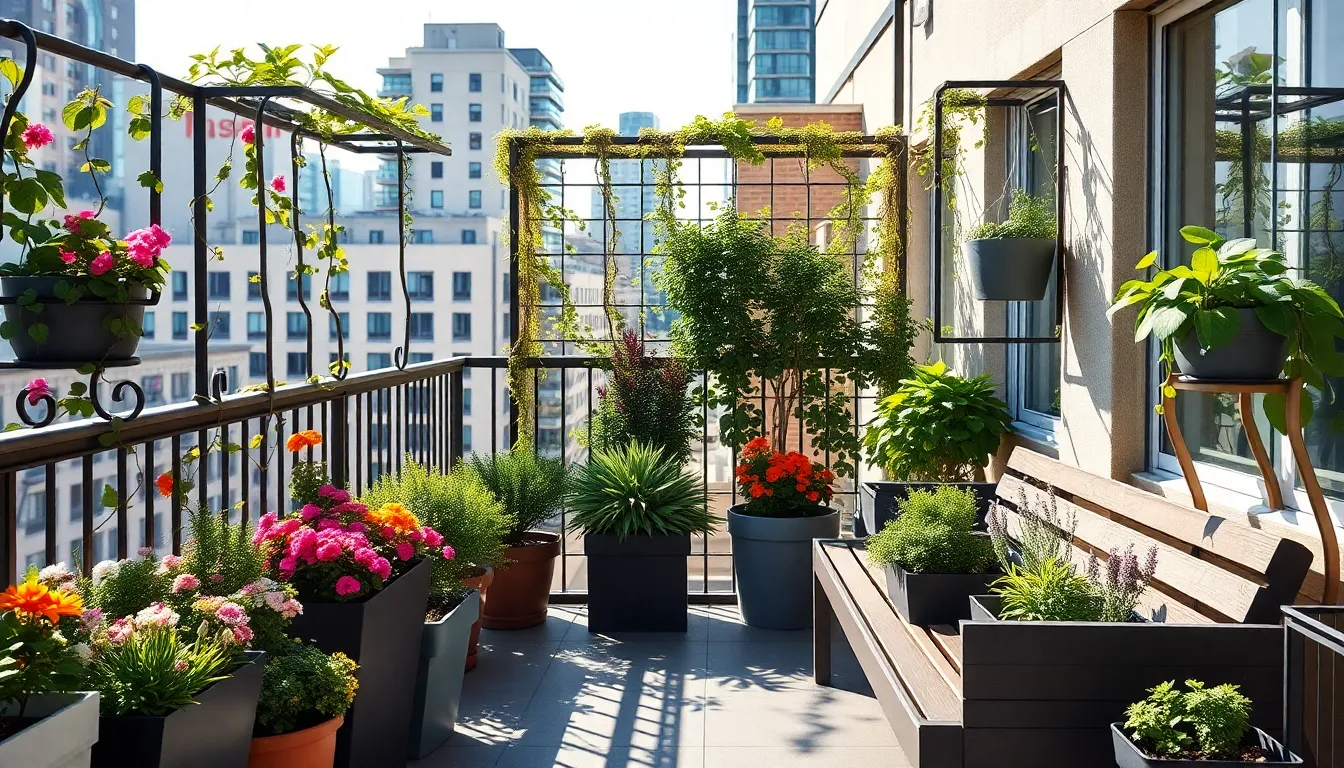
Transforming your balcony into a productive garden requires strategic planning to make every square foot count. Smart design approaches can turn even the smallest balcony into a thriving green space.
Corner Planting Arrangements
L-shaped planters fit perfectly into balcony corners and transform unused space into productive growing areas. These specialized containers follow the natural lines of your balcony’s architecture while providing maximum planting surface without blocking walkways.
Corner trellises add vertical growing potential for climbing plants like peas, beans, and flowering vines. Installing these structures in corner spaces creates natural focal points while supporting plants that grow upward rather than outward. The triangular configuration maximizes both beauty and functionality in tight corner areas.
Stacking corner planters in graduated sizes creates terraced growing levels that accommodate different plant heights. This arrangement allows taller plants to occupy the back positions while shorter herbs and flowers flourish in front tiers.
Rail-Mounted Garden Systems
Rail planters attach directly to balcony railings and create garden space without consuming precious floor area. These specialized containers come in various lengths to fit different railing configurations and can support herbs, flowers, or compact vegetables.
Over-the-rail planters hang on the exterior side of balcony railings and double your growing capacity instantly. These innovative systems provide additional planting space while maintaining full access to your balcony floor for furniture and movement.
Adjustable rail mounting systems accommodate different railing widths and styles found in apartments and condominiums. These versatile answers ensure secure attachment while allowing easy removal for seasonal changes or relocation.
Compact Seating with Built-In Planters
Benches with integrated planters combine comfortable seating with productive growing space in one efficient design. These dual-purpose pieces typically feature planter boxes built into the bench structure, allowing you to enjoy your garden while sitting among the plants.
Ottomans with removable plant tops offer versatile seating options that transform into growing containers when needed. These clever designs provide hidden storage beneath while supporting small herb gardens or flowering displays on top surfaces.
Storage benches with planter compartments maximize functionality by providing seating, storage, and growing space simultaneously. These multi-purpose answers work particularly well in small balconies where every piece of furniture must serve multiple functions.
Creative DIY Solutions for Tiny Garden Spaces
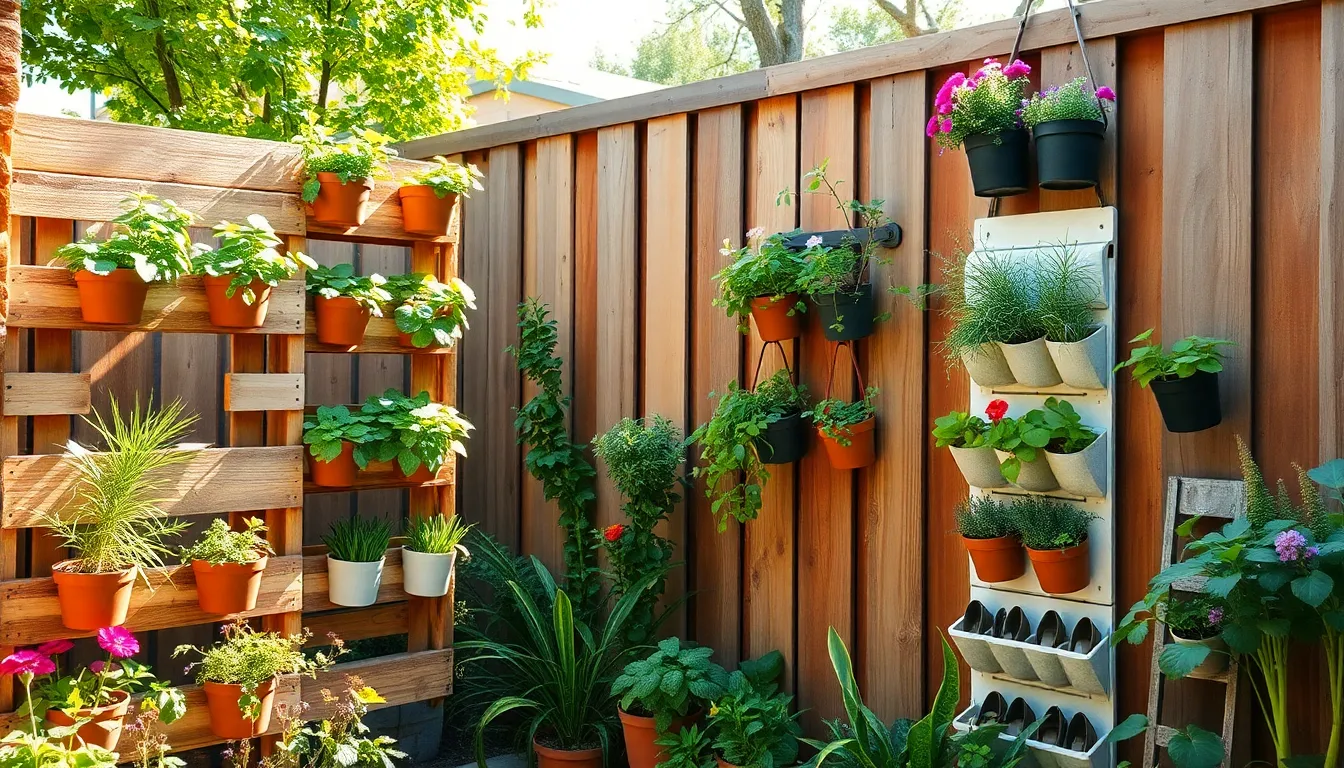
Budget conscious gardeners can transform everyday items into functional growing spaces with these innovative approaches. We’ll explore three practical methods that maximize your growing potential without very costly.
Repurposed Container Gardens
Terra cotta pots create stunning tiered displays when stacked at different heights, allowing us to showcase multi-colored flowers while saving valuable ground space. We can arrange these pots in pyramid formations or ascending steps to add visual drama to any small area.
Vinyl gutters transform into space saving planters that mount easily along fences, railings, or walls. These elongated containers work perfectly for shallow rooted plants like lettuce, herbs, and strawberries.
Old barrels provide rustic charm while offering substantial growing space for larger plants like tomatoes or dwarf fruit trees. We drill drainage holes in the bottom and position them strategically around patios or yard corners.
Wheelbarrow gardens offer ultimate mobility for seasonal growing needs. After drilling proper drainage holes, we can relocate these portable gardens to follow sunlight patterns or protect plants from harsh weather.
Pallet Garden Projects
Wooden pallets create impressive vertical gardens that maximize growing space in the smallest footprints. We position pallets upright against walls or fences, then fill the slats with soil and plants to create living walls perfect for herbs, succulents, or trailing flowers.
Pallet planter boxes provide elevated growing areas that improve drainage and reduce bending during maintenance. We can construct these boxes by dismantling pallets and reassembling the boards into custom sized containers.
Climbing plant supports emerge naturally from pallet structures, as vines and trailing plants use the wooden slats as built in trellises. This setup works exceptionally well for peas, beans, and flowering vines that need vertical support.
Shoe Organizer Planters
Hanging shoe organizers transform into instant herb gardens when mounted on walls, fences, or balcony railings. We fill each pocket with potting soil and plant individual herbs like basil, oregano, or thyme for easy kitchen access.
Maintenance becomes effortless with these wall mounted systems since each plant occupies its own compartment with proper spacing. We can water and tend individual plants without disturbing neighboring growth.
Space efficiency reaches new heights as these organizers use vertical wall areas that typically remain unused in small gardens. The clear pockets allow us to monitor root development and soil moisture levels at a peek.
Space-Saving Plant Varieties for Small Gardens
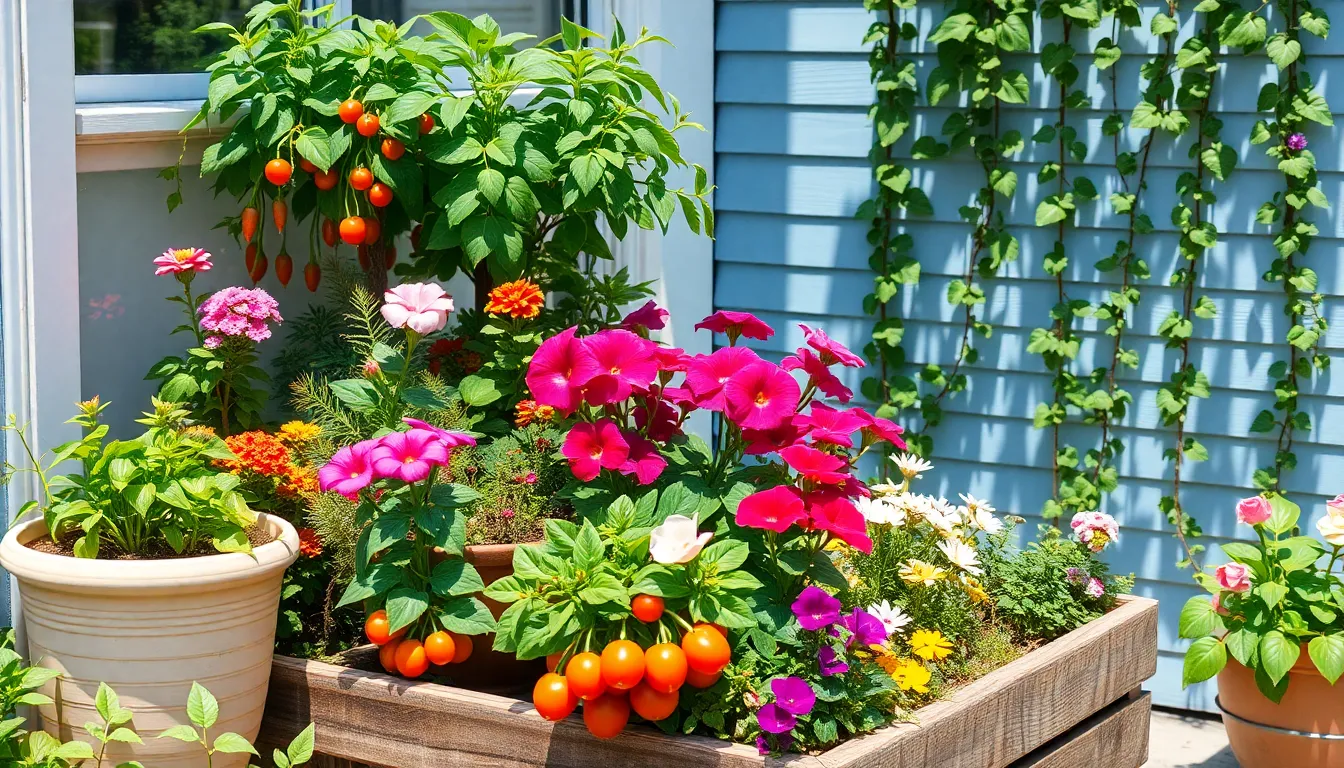
Choosing the right plants makes all the difference when we’re working with limited square footage. We can create thriving gardens by selecting varieties specifically bred for compact spaces.
Dwarf Vegetable Cultivars
Dwarf vegetable cultivars deliver impressive yields while occupying minimal garden space. These compact plants produce full-sized vegetables on smaller plants, making them perfect for container gardening and raised beds.
Compact tomatoes like cherry tomato varieties grow in small pots and provide continuous harvests throughout the growing season. We can choose determinate types that stay under 3 feet tall or bush varieties perfect for hanging baskets.
Dwarf peas climb to just 2-3 feet high and don’t require extensive trellising systems. Sugar snap peas and snow peas work exceptionally well in small containers or along short fence lines.
Small carrot varieties including Paris Market and Thumbelina cultivars grow in shallow containers just 6-8 inches deep. These round carrots mature quickly and fit perfectly in window boxes or compact raised beds.
Compact lettuce varieties like Little Gem romaine and space-saving buttercrunch types can be harvested continuously through cut-and-come-again methods. We can succession plant these every 2-3 weeks for constant fresh greens.
Compact Flowering Plants
Compact flowering plants provide maximum color impact in minimal space while blooming continuously throughout the growing season. These varieties focus their energy on flower production rather than extensive foliage growth.
Compact roses including patio roses and miniature varieties bloom repeatedly in containers as small as 12 inches wide. Knockout roses and fairy roses stay under 2 feet tall while producing abundant flowers from spring through fall.
Petunias in wave and compact varieties spread horizontally to fill containers without growing tall. We can choose from trailing types for hanging baskets or mounding varieties for ground level displays.
Geraniums offer consistent blooms in small pots and require minimal maintenance throughout the growing season. Ivy geraniums trail beautifully from window boxes while upright varieties provide structured color in tight spaces.
Trailing Plants for Vertical Interest
Trailing plants maximize our vertical growing space while adding dramatic visual appeal to small garden areas. These plants grow upward instead of outward, creating living walls and green screens.
Ivy varieties including English ivy and Boston ivy provide dense coverage on walls and fences without requiring large root systems. We can train these plants to cover unsightly surfaces while maintaining compact ground footprints.
Clematis produces stunning flowers while climbing existing structures like mailbox posts or porch railings. Large flowered varieties like Jackmanii and sweet autumn clematis bloom at different times for extended seasonal interest.
Morning glories germinate quickly from seed and create privacy screens within a single growing season. These annual vines climb 6-10 feet tall and produce colorful trumpet-shaped flowers that open each morning.
Conclusion
Small-space gardening proves that we don’t need acres of land to create our own green paradise. With the right techniques and creative thinking we can transform any compact area into a thriving garden that brings joy and fresh produce to our daily lives.
The key lies in maximizing every inch through vertical answers container arrangements and strategic plant selection. Whether we’re working with a tiny balcony windowsill or indoor corner these approaches help us grow more plants than we ever thought possible.
We’ve shown that budget-friendly DIY projects and repurposed materials can create stunning garden displays without very costly. From ladder planters to shoe organizer herb gardens the possibilities are truly endless when we think outside the traditional gardening box.
Start small choose plants that suit your space and watch your compact garden flourish into something extraordinary.
Frequently Asked Questions
What are the best plants for small-space gardening?
Compact herbs like basil, thyme, and mint are ideal for small spaces. Cherry tomatoes, lettuce, and dwarf peas work well in containers. For flowers, choose patio roses, petunias, and compact annuals. Trailing plants like pothos, ivy, and spider plants maximize vertical space while adding visual appeal.
How do I start a vertical garden in a small space?
Begin with wall-mounted planters or a simple trellis system. Use modular planters, hanging baskets, or repurposed ladders to create vertical growing areas. Ensure proper drainage and choose lightweight containers. Select climbing or trailing plants that grow upward to maximize your vertical space efficiently.
What containers work best for small-space gardening?
Any container with drainage holes works well. Creative options include old boots, wooden crates, terra cotta pots, and repurposed barrels. Window boxes, hanging baskets, and tiered plant stands are excellent for maximizing space. Ensure containers are appropriately sized for your chosen plants’ root systems.
Can I grow vegetables in window boxes?
Yes! Window boxes are perfect for compact vegetables like lettuce, cherry tomatoes, small carrots, and herbs. Choose boxes at least 8 inches deep with proper drainage. Place them in sunny locations and use succession planting techniques to ensure continuous harvests throughout the growing season.
How do I create a productive balcony garden?
Maximize your balcony with corner planters, rail-mounted systems, and vertical structures. Use L-shaped planters and corner trellises to optimize unused space. Consider compact seating with built-in planters and hanging systems that don’t consume floor area. Plan strategically to ensure adequate sunlight for all plants.
What are some budget-friendly DIY small garden ideas?
Repurpose items like old ladders, wooden pallets, vinyl gutters, and shoe organizers into planters. Create vertical gardens using pallet wood or transform wheelbarrows into mobile garden beds. Use everyday containers like boots and crates for unique displays while maintaining proper drainage for plant health.
How do I maintain healthy plants in containers?
Use quality potting soil and ensure proper drainage in all containers. Water regularly but avoid overwatering. Feed plants with appropriate fertilizers on a consistent schedule. Group plants with similar water and light requirements together. Monitor for pests and diseases more frequently than ground-planted gardens.
What indoor growing options work for apartments?
Create countertop herb gardens with easy-to-grow herbs. Install living wall systems to maximize vertical space. Use under-cabinet areas with LED grow lights for hydroponic systems. Macrame plant hangers and ceiling-mounted planters utilize overhead space while enhancing your home’s aesthetic appeal.






